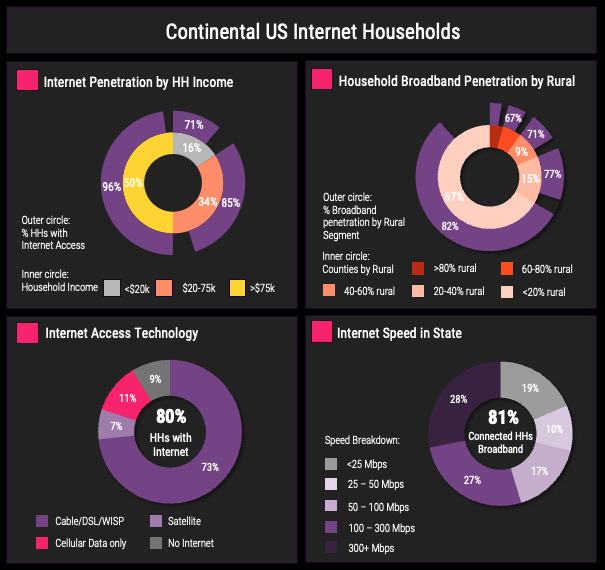
Sixty-five percent of all homes in the continental United States now enjoy broadband speeds, according to our latest Broadband America report. That number increases to a somewhat impressive 81% of homes when we disregard households that are not connected at all (we’ll come back to that). Further, of these connected homes, 55% enjoy speeds greater than 100 Mbps, which is the FCC’s new threshold for “broadband”.
Speeds keep getting faster and many of the major broadband providers now offer 2 Gbps service across their footprint. Regardless of the fact that the use case for that kind of speed is very limited (perhaps for online gamers?) many consumers will upgrade with the belief that faster is always better. But this increased speed potentially causes a different data bottleneck within the home. Many current WiFi routers do not provide a fast enough service to support the 2 Gbps speeds. Case in point, I have a 1 Gbps service to my home but when I run a speed test, it typically only shows around 600 Mbps. The missing 400 Mbps is lost with the WiFi connection, despite the router sitting in the same room as my computer, and if I plug in an Ethernet cable (rather than using WiFi) I get a far better speed.
So that means we need faster WiFi, unless we are all okay snaking cables around our homes like it’s 1999 again. That puts pressure on the carriers – the same carrier that is selling us the 2 Gbps service – to upgrade the routers that they provide. The latest WiFi standards certainly offer a (theoretically) fast enough service, but there is also a compelling argument that WiFi should add a 6 GHz band to complement today’s 5 and 2.4 MHz bands. This would not only improve speed and capacity, but also offer lower latency, which is increasingly important for gaming, video calls and so forth. Besides, if the carriers need to start upgrading customer premise equipment, it behooves them to future proof as much as they can.

But enough about those of us fortunate enough to consider 2 Gbps. There are still 19% of connected homes with less than 25 Mbps and more than half of those homes get speeds of less than 10 Mbps. Add to that, the 9 percent of homes in the US that have no connection at all, and an additional 11% that are smartphone-only homes. Many of these homes are in rural markets and need improved Internet speeds (or any Internet speed!) in order to jump the digital divide. That is a market of severely diminishing returns for cable-based solutions and is a clear opportunity for fixed wireless access from the mobile carriers. Indeed, FWA is clearly becoming a strong alternative for many consumers: Verizon and T-Mobile have more than 7 million FWA subscribers between them, and we can expect that number to increase significantly over the next year or so now that AT&T is also offering FWA service. Further, more than half of the homes with FWA attain speeds greater than 100 Mbps, according to the Broadband America report.
But not all of the unconnected homes are due to lack of availability. There is also the affordability issue, which is where the Affordable Connectivity Program (ACP) came in. The problem here is that this program has run out of money and will cease to exist at the end of May. While cable operators pledge to keep supporting the ACP subscribers to an extent, without a fresh boost in funding, we can expect to see an overall drop in Internet households over the next few years, especially when you consider the current economic environment that has already put a strain on lower income households. The result? A possible digital divide that is even more extreme than today, with the lucky enjoying 2 Gbps gaming, and the less fortunate back to seeking out free public WiFi to complete their homework. Let’s hope it’s at least faster WiFi running on 6 GHz.